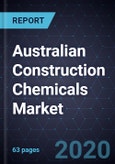Growth in Specific End Sectors to Drive the Demand for Construction Chemicals
Within the Australian construction industry, the construction chemicals market is estimated by the construction activity being done within the country, as increasing construction activity implies an increase in the demand and use of construction chemicals. Growth in construction activity for specific end sectors, trends in refurbishment, demand for high-rise buildings, increasing awareness of the benefits of high-quality products, and demand for green buildings are the key drivers of growth for the Australian construction chemicals market. However, weak construction activity in retail, office, mining, and manufacturing segments, the increasing price of raw materials, and the current weakness in economic conditions restrain the pace of market growth. The historic growth trajectory is expected to be sustained moving forward. With the strength in some end markets neutralised by weakness in others, the overall construction chemicals market is expected to grow steadily from 2018 to 2025.
The publisher conducted a study on the construction chemicals market in Australia from 2018 to 2025, covering products in admixtures, waterproofing, repair and rehabilitation, flooring chemicals, sealants, tile adhesives, grouts, and other construction chemicals. Within the study, the building and construction activity in Australia was measured by the work done in residential buildings, non-residential buildings, and engineering construction (e.g., transport engineering, utilities and resources, oil and gas). The residential building sector is sub-categorized based on residential buildings, houses, and other dwellings, including the work done on alterations and additions. Residential building activity, therefore, comprises both new home construction and also major renovation projects. The non-residential building covers accommodation, entertainment and recreation, health, aged care, religion, education, agriculture and aquaculture, warehouses, factories, offices, transport, retail and wholesale, other commercials, and other industrial sectors.
The constantly changing needs of construction chemicals and the evolving construction industry require construction chemicals companies to adopt upcoming trends. Regardless of the product portfolio offered, the only way companies can stay relevant is to prioritize the trends of the construction industry that include increasing adoption rates of refurbishment, increasing construction of high-rise buildings, and increasing awareness on eco-friendly and safe products. The ability to understand and innovate the products according to the trends will allow companies to adapt to the constant changes in the industry.
Research Highlights
- Technology advances in high-quality and safe construction chemicals are likely to receive investment from major manufacturers.
- Diversification of products is also seen as an effective growth strategy.
- Sika's acquisition of Parex is the single-most-important shift in the competitive landscape. However, the fragmentation of the market in the Tier-II and below segments leaves further room for consolidation.
- Admixtures and waterproofing chemical products have remained the main contributors to the total construction chemicals market revenue. However, sealants and tile adhesives are expected to gain market share in the next 4 years.
Key Issues Addressed
- What are the key growth drivers for the Australian construction chemicals market?
- What are the key restraints to growth?
- What is the size and growth forecast for the total market?
- What technology, demand, and service trends are likely to impact the opportunity moving forward?
- What competitive tools provide differentiation in this market, and which are the leading construction chemical manufacturers?
- What emerging opportunities exist for competitors moving forward?
Table of Contents
Companies Mentioned (Partial List)
A selection of companies mentioned in this report includes, but is not limited to:
- Parex
- Sika








